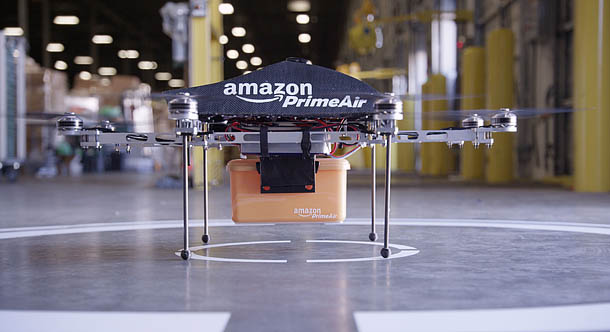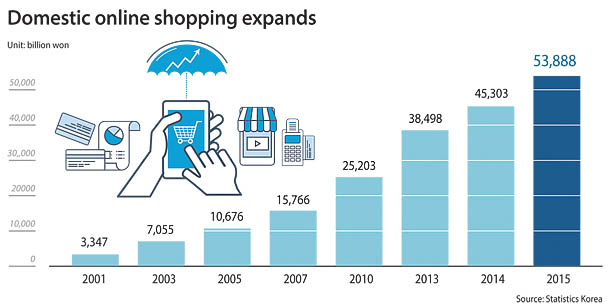How technology is transforming logistics

Amazon Prime Air, a delivery drone developed by e-commerce giant Amazon, was design to deliver packages to customers in 30 minutes or less. [AMAZON]
While existing logistics companies are focusing on developing robots and automated systems at warehouses and their overall supply chains, IT companies are also entering the logistics industry to provide software-based solutions deploying artificial intelligence, big data and Internet of Things to make processes smarter.
SK C&C, the information communication technology arm of SK Group, recently formed a joint-venture with Jusda, a logistics subsidiary of Taiwanese Foxconn Technology Group, to launch a platform that combines logistics and top-notch technologies.
“We will combine the logistics expertise of Jusda and SK C&C’s technologies such as IoT, cloud computing, big data and AI,” SK C&C said in a statement Friday. “The logistics business is under disruptive transformation boosted by the development of IT and we aim to spearhead such trends with the newly established joint-venture.”
SK C&C’s artificial intelligence service Aibril, based on IBM’s Watson, will help forecast logistics demand and find optimal routes and delivery methods for packages through the venture’s new solution named Kerol. SK C&C inked a partnership with IBM to co-develop Watson’s Korean service, due for release by next year.

Samsung SDS, the ICT arm of Samsung Group, also is upgrading its logistics solution Cello, released in 2011.
Last month, the company reintroduced Cello in a cloud-based on-demand software model that allows customers to access the software through the Internet on a subscription basis.
Cello offers big data analysis for optimized package loading and delivery services. For instance, the loading optimization function enables warehouse workers to know what packages to load first considering customer needs. Also, a virtual warehouse system offers three-dimensional virtual reality view of the warehouse, which helps employees manage warehouses remotely.
“As Cello solution is provided in the form of on-demand software, diverse range of customers can easily and quickly experience high-technology logistics system,” said Shin Woo-yong, an executive from Samsung SDS.
CJ Korea Express’s (CJ Korex’s) TES Innovation Center in Korea Integrated Freight Terminal in Gunpo, Gyeonggi, demonstrates how a logistics company is banking on IT and robot development to secure future growth engines. “Logistics has often been perceived as a 3D [dirty, dangerous and demeaning] job, but this center is a test-bed to make the industry a new leader in the fourth industrial revolution,” said executive vice president Richard Shin.

Above, a robot under development by CJ Korea Express automatically delivers packages to appropriate packaging stations, and a monitoring and control center installed at the TES Innovation Center that makes delivery processes visible. [CJ KOREA EXPRESS]
The robot, which currently moves at 60 meters per minute, about the speed of a conveyer belt, has sensors to avoid collisions with machines or people. It is scheduled to scuttle around the company’s warehouses by 2018.
The company is also preparing for drone deliveries. CJ Korex has three drones, dubbed CJ Sky-Door, in development. There are complicated issues surrounding drone deliveries aside from the technology. The company must get approval from the government to fly drones in certain areas. Still, as Amazon and Google have already made headway in developing delivery drones, the company said the project is “necessary” to prepare for changes.
Amazon’s Prime Air, designed to deliver packages to customers’ doors in 30 minutes or less using drones, is preparing for launch though it is deadlocked in U.S. Federal Aviation Administration regulations.
“In the past, logistics was considered a simple and repetitive work of a company’s purchasing department however in the evermore competitive global market logistics has become part of a company’s competitive edge on top of technology, product quality and price,” said Park Jung-ho, CEO of SK C&C.
The global logistics robots market will grow steadily at a compound annual growth rate of about 33 percent from 2016 through 2020, said technology research firm Technavio.
“The growing online shopping space is the primary growth driver for this market,” Technavio said in a Global Logistics Robots Market report. “The market is expected to spur the demand for a faster and more efficient delivery mechanism owing to growing consumer preference towards same day delivery purchases.”
The huge growth in domestic online shopping markets seems to support the trend. The domestic online shopping market grew from 3.35 trillion won in 2001 to 53.89 trillion won in 2015, expanding at an average 22 percent annually, according to Statistics Korea.
BY KIM JEE-HEE [kim.jeehee@joongang.co.kr]










with the Korea JoongAng Daily
To write comments, please log in to one of the accounts.
Standards Board Policy (0/250자)